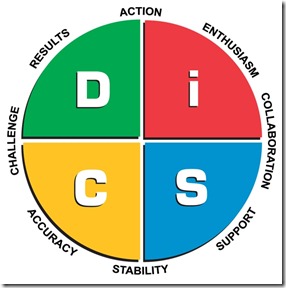We recently blogged about defining the organization’s hiring needs using a well-thought-out job description. Once the job description has been developed, the challenge is to identifying the right candidates and make sure their skills and personality are a good fit for your team. To aid in that process, we often use behavior and value assessments, often referred to as personality testing. While only a few organizations use personality testing as part of the hiring process, when used properly testing can be useful in highlighting the strengths and weaknesses of a candidate. There are many personality testing tools to choose from, including Myers-Briggs and the Keirsey Temperament Sorter. They all measure similar personality traits, so we will focus on the one we recommend for hiring: DISC.
We find DISC and values a useful combination because it defines responses to various situations, including behavioral communications models, which tend to highlight trends that promote team effectiveness. The acronym DISC stands for the four aspects of interpersonal behavior:
As with all such tests, the questions asked will reveal a dominant personality trait or type, but that score or ranking should not be used to eliminate a candidate from consideration. Instead, it should provide some insight into how well that candidate will fit in the role assigned based on his or her personality traits, and how well he or she can adapt to the role and the company. There are six key values, and using their ranks, combined with DISC, gives a clear picture of how someone will perform in a specific role.
For example, if you have specific functions that need to be completed, candidates who rank higher for dominance and compliance might be better suited, since D and C types are task-oriented. However, if you need someone with strong interpersonal skills, I and S types tend to be people oriented.
“In working with Pacific Crest Group, we helped them look at people’s behavioral and values profiles together,” said business consultant Mark Friedler. “The DISC shows HOW someone does things, the PTSI Values shows WHY they do it. We recommend using a unique combination of DISC and Values that helps PCG accurately determine the ideal fit for an existing team member or new hire. This model is often applied to an entire company to give a graphical and easy-to-understand picture of their team and what the company needs to be successful. A valuable result of this process when done at a company level is that it improves communication and understanding within the team. In fact, we did this with PCG and its own team.” (For more information, you can contact mark@markfriedler.com or call 415.683.6601)
“When using personality testing for hiring assessment, the objective is to uncover motivational as well as behavioral values – what makes the job candidate tick – and then match those values to the requirements of the position. You also want to use those values to assess the match between the candidate and his or her supervisor. Will they work well together as a team? Do their personality types mesh or clash in terms of teamwork and communications?
Also remember that good hiring practices are about fulfilling needs, not likes. You might find a candidate who is a great person, amiable, and seems like a great personality for your organization, but that may not be the personality you need. That person may rank high in the Influence category or in S for Steadiness, However, if you are seeking an aggressive sales professional you might be better served looking for a candidate who scores higher in Dominance.
Personality testing can be revealing during the hiring process, but it is only one small part of the process. More can be revealed by an effective interview, which is a topic for a future blog.


